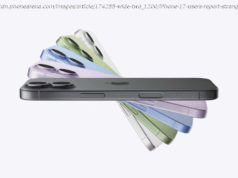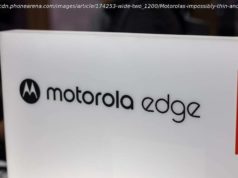The first iPhone was poor technologically, but it defined a genre and it’s now a smartphone powerhouse.
Update: We’re just days away from the next chapter of the iPhone story, with the iPhone 8, iPhone 7S and iPhone 7S Plus expected to launch on September 12. iPhone 8 iPhone 7S iPhone 7S Plus
It was January 9 2007 when Steve Jobs took to the stage of the Moscone Center in San Francisco to announce the arrival of the iPhone, which went on sale on June 29 of the same year. That’s a full 10 years ago!
If you find it difficult to remember that far back, a book about a boy wizard hit shelves for the first time and people were flocking to the cinema to get teary-eyed at Will Smith in The Pursuit Of Happyness.
While our pop music and movie choices may not have improved much, smartphones were changed forever: from that point on, touchscreens, apps and digital media were the way forward.
And the next big turning point in smartphone history could be just around the corner as we prepare ourselves for Apple’s next big offering, with rumors pointing towards the iPhone X / iPhone Edition . iPhone X iPhone Edition
Click on through to see every version of the iPhone from the first ten years.
Launched: June 2007 (US) , November 2007 (UK)
Steve Jobs introduced the iPhone as three devices in one: a touchscreen iPod, a revolutionary mobile phone, and a truly mobile web browser.
Now we take touchscreens, digital media playback and web access for granted, but in 2007 the iPhone was unlike anything that had appeared before. Its 3.5-inch screen had a 320 x 480 pixel reoslution (one of the best displays of the time) , with a 2MP camera built in, and up to 8GB of storage.
Third-party apps were not yet allowed on «iPhone OS». In the TechRadar review, we noted that despite several shortcomings, the phone had «changed the mobile device landscape… multitouch will prove to be a model for interfaces in the future». TechRadar review
Launched: July 2008
High-speed connectivity was big news in 2008, which is why the second generation iPhone included 3G in its moniker (rather confusingly, as this was the second generation iPhone) . It also brought with it a thinner shape, a plastic back and – crucially – support for the newly launched App Store.
The app store model worked so well you’ll now find it replicated in everything from your smart TV to your Windows 8 laptop, and the change helped Apple’s phone really start to gain traction. Windows 8
We said in our iPhone 3G review that buyers would be «amazed by the function and feel of this handset». The iPhone era had begun in earnest. iPhone 3G review
Launched: June 2009
The iPhone 3GS upgrade was viewed as disappointingly minor at the time, but look at the detail and a different picture emerges: as well as faster performance, the new handset offered a better 3.2MP camera (that could now record video as well as take photos) , extra storage options and voice control (the precursor to Siri) . iPhone 3GS
The display was the same 3.5-inch 320 x 480 screen, and the device’s appearance remained largely unchanged from the 3G model. TechRadar’s take on the unit praised the multimedia and internet capabilities, while still finding niggles with the camera, call quality and battery life – this was the first of the more iterative updates to the iPhone, but did enough to keep users happy. take on the unit
Launched: June 2010
If the 3GS was a minor upgrade, the iPhone 4 was a serious step up – a new, flat design with an integrated antenna (although questions were raised about how you held the device) , a high-resolution Retina display (640 x 960 pixels) that showed the rest of the world how it was done and a superior 5MP camera (featuring HD video recording) , on top of internal performance improvements. iPhone 4
The competition was catching up, and Apple had responded in brilliant fashion. We were certainly impressed, despite some reservations about the high price, saying «It’s intriguing to see record-breaking numbers queuing up to pick up this device – but after playing with it for a few days, you can see why.»
Launched: October 2011
Apple pulled out the «S» tag again for the fifth generation handset, indicating a minor upgrade rather than a major overhaul.
The design of the iPhone 4S was the same, but inside was Apple’s new A5 processor, vastly improved graphics capabilities and an 8MP camera with 1080p video recording. iOS was evolving at the same rate as the hardware, of course, and Siri began life as an iPhone 4S exclusive. iPhone 4S
The improvements were enough to persuade us to describe it as «the best thing Apple has ever created» in the official TechRadar review.
Launched: September 2012
After six handsets, Apple finally decided it was time to tweak the iPhone’s screen size and aspect ratio.
Coming in at 20% lighter than its predecessor, the 2012 iPhone adopted a 4-inch screen, running at 640 x 1136 pixels.
Otherwise, despite the usual speed bump and a stronger antenna, it was very much business as usual in terms of the design and capabilities.
Our biggest gripe in our iPhone 5 review was with the aging iOS, but with iOS 7 arriving on September 18 that issue is very much negated, which will please a number of iPhone 5 users who’ve been holding onto the handset for nearly a year. iPhone 5 review iOS 7
Launched: September 2013
The big step in the seventh stage of the iPhone’s evolution was the arrival of the iPhone 5C, a slightly cheaper, plastic-backed model to help battle Android in the busy mobile middle market. The signs were there already – remember Apple kept the iPhone 4 and 4S on sale during the iPhone 5 era. iPhone 5C
Apart from the plastic shell and larger battery, though, the iPhone 5C was, in terms of specs, a carbon copy of the iPhone 5 – which was retired to make way for the two new handsets.
As for the flagship iPhone 5S, it was a case of under-the-hood improvements again: more power, a better camera, and a fancy fingerprint reader hidden under the home button. The bigger changes arrived with iOS 7, the most radical revamp of the mobile operating system since the App Store arrived back in 2008. iPhone 5S iOS 7 App Store
Launched: September 2014
After the smaller changes that came with the iPhone 5C and iPhone 5S, Apple was back to its revolutionary best with the following generation, as the iPhone 6 and iPhone 6 Plus brought the biggest alterations in design and features since the leap from the iPhone 4S to the iPhone 5. iPhone 6 iPhone 6 Plus
The most striking change the eighth generation iPhones ushered in was undoubtedly the screen size, with the iPhone 6’s display leaping from the iPhone 5’s 4 inches to 4.7 inches. Apple also upped the resolution from the 1136 x 640 of previous iPhones to 1334 x 750. This meant that the larger screen still had a high pixel density of 326ppi (pixels per inch) , so image quality was incredibly sharp and detailed.
As the name suggests, the iPhone 6 Plus went even larger, with a whopping 5.5-inch display, marking Apple’s first foray into the phablet market. The iPhone 6 Plus also got a resolution boost to full high definition, 1920 x 1080. With a pixel density of 401ppi, not only does the iPhone 6 Plus have the largest screen of any iPhone ever, but it also has the clearest.
The iPhone 6 and iPhone 6 Plus also benefit from Apple’s use of «dual-domain pixels», which along with the 1300: 1 contrast ratio makes the screen on the handsets look absolutely fantastic.
Both the iPhone 6 and the iPhone 6 Plus also ditched the industrial and sharp-edged design that had been with the iPhone for four generations, in favour of a more ergonomically-pleasing chassis with a screen that curves into a body with rounded edges and corners.
Both handsets feature metal backs, and as we pointed out in our reviews, they take a lot of design language from the iPad Air, resulting in a product that looks and feels genuinely premium.






